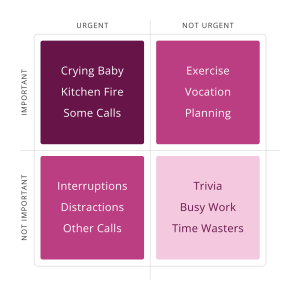The intertwining of different responsibilities and the need for seamless coordination across various teams present a significant challenge to effective time management. This complexity is particularly felt by account executives and cross-functional teams, who must balance a myriad of tasks while ensuring that collaboration remains smooth and productive. The complication arises from the need to juggle diverse duties without a clear strategy for prioritization, leading to potential inefficiencies and stress.
In this blog we’ll examine how incorporating a structured approach, such as the Eisenhower Matrix, can revolutionize time management strategies. By categorizing tasks based on their urgency and importance, this approach provides a clear methodology for individuals and teams to optimize their workflow. This ensures that not only are individual tasks managed more efficiently, but collective objectives are also met in a timely and cohesive manner, fostering a more productive and less chaotic work environment.
The Eisenhower Matrix Disrupts Conventional Time Management Practices
The Eisenhower Matrix gained popularity largely due to its association with Dwight D. Eisenhower, the 34th President of the United States. Eisenhower, renowned for his roles as a five-star general during World War II and as NATO’s first supreme commander, famously applied a similar method to manage his sprawling array of tasks and responsibilities. This prioritization system was not merely about sorting tasks; it was about strategic decision-making and effective leadership under pressure.
This framework represents a groundbreaking shift in time management strategies, challenging the traditional ways we prioritize our day-to-day activities. This method employs a simple yet effective four-box grid, categorizing tasks based on urgency and importance. The axis of this grid offers a clear demarcation: the horizontal axis stretches from “Urgent” to “Not Urgent,” while the vertical axis runs from “Important” to “Not Important.” By placing tasks within these defined quadrants, individuals can visually discern which activities demand immediate attention and which can wait, with the “Urgent and Important” section—located in the top-left quadrant—taking precedence. This framework doesn’t just organize tasks; it provides a clear strategy for approaching the day’s demands, shifting focus from a long list of to-dos to a structured action plan with clear priorities.

Categorize and Prioritize Tasks for Urgency and Importance or Compromise Productivity
The Eisenhower Matrix transcends its role as a mere time management tool, emerging as a crucial framework for aligning diverse functions and priorities within cross-functional teams. It addresses a common time management pitfall known as the Mere Urgency Effect, where individuals mistakenly prioritize urgent yet less significant tasks over those that are important but not immediately pressing. This skewed prioritization, driven by the deceptive allure of urgency, can lead to significant inefficiencies and hinder the achievement of long-term objectives. The Eisenhower Matrix offers a clear solution by enabling team members to categorize tasks based on their actual urgency and importance, thus avoiding the trap of perceived urgency.
By distinguishing between tasks that appear urgent and those that are genuinely important, the Eisenhower Matrix guides both individual contributors and teams in dedicating their efforts to activities that truly advance the team’s goals. This strategic focus is essential in a collaborative setting where misaligned priorities can lead to frustration and wasted resources. Implementing this framework helps in reassessing priorities, ensuring that time and resources are invested wisely, and enhancing both individual productivity and collective output. Furthermore, by integrating the Eisenhower Matrix into daily workflows, account executives and cross-functional teams can cultivate a culture of efficiency and purposeful action. This approach not only streamlines task management but also aligns daily actions with overarching objectives, thereby optimizing both individual and team performance within the collaborative work environment.
Adjust the Eisenhower Matrix to Suit the Shifting Dynamics of Your Workplace and Team
The Eisenhower Matrix, universally valued for its simplicity, provides extensive flexibility to accommodate diverse work styles, industries, and team dynamics. It particularly shines when adapted to the varied needs of professionals across fields. For creative professionals, the matrix can be an invaluable tool, helping to ensure that projects, which may not seem urgent but require significant time and creative energy, receive the focused attention they need. By highlighting the ‘important but not urgent’ quadrant, these professionals can effectively manage and advance their long-term, value-driving creative endeavors. Similarly, in sectors like technology or finance, known for their rapid pace, the matrix can be fine-tuned to help distinguish between tasks that are truly urgent and those that may not require immediate action. Customizing the matrix to suit the distinct requirements of each professional realm enhances its utility, making it a more effective instrument for navigating the complex landscape of modern work challenges and responsibilities.
Moreover, the adaptability of the Eisenhower Matrix extends to team settings, where it can be molded to align with collective workflows and dynamics. A team leader, for example, might leverage the matrix to delegate tasks, considering each member’s strengths and current workload to ensure a fair and productive distribution of urgent and important responsibilities. The framework can also be expanded to incorporate categories or labels that mirror team-specific priorities or objectives, cultivating a mutual understanding and consistent approach to task prioritization. Prompting team members to personalize their individual matrices according to their unique roles encourages a unified yet flexible approach to collaboration, promoting efficiency and cohesion within the group. By engaging with the matrix in this manner, teams and individuals not only refine their prioritization skills but also enhance their overall productivity and alignment with shared goals.
Navigate the Path of Prioritization to Salvage Team Success
Managing multiple responsibilities and ensuring fluid collaboration poses a significant time management challenge. The complexity of balancing diverse tasks without a clear prioritization strategy can lead to inefficiency and heightened stress levels. The Eisenhower Matrix emerges as a beacon of clarity amidst this chaos, offering a structured approach to categorize and prioritize tasks effectively. By distinguishing between urgency and importance, this methodology not only streamlines individual workflow but also harmonizes the collective efforts of teams, ensuring that both personal and shared objectives are achieved with efficiency. Additionally, the adaptability of the Eisenhower Matrix allows for customization to fit diverse work styles and team dynamics, further enhancing its utility and effectiveness in various settings. The adoption of the Eisenhower Matrix enables a transformation from a reactive to a strategic approach, fostering a work environment that is both productive and less fraught with unnecessary urgency. This shift not only enhances productivity but also instills a sense of purpose and direction, proving that when it comes to time management, the right framework can turn chaos into order and transform potential into achievement.
